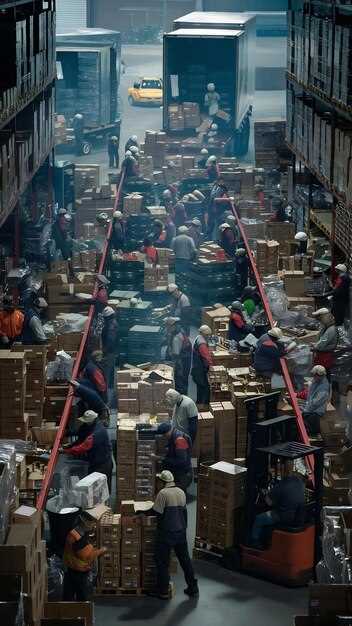Prioritize in-house talent and build buffers in your manufacturing network to weather labor gaps. This approach keeps owned assets resilient and reduces risks across critical operations. The chief operations team should define who owns each action, what success looks like, where to invest first, and the thing to watch is inventory velocity, using real-time estimates from the internet and internal data. A couple of well-placed hires in logistics, quality, and maintenance can cut response time by 20-35% and cut disruptions in half for key lines.
What drives the shortage? Retirement waves, limited immigration, and a shift toward higher automation tighten the labor pool. Manufacturing sites often depend on skilled technicians, which makes short-term gaps feel bigger where demand surges. Think of planners adjusting a target like an archer, aiming for balance between orders and capacity. The supply chain party of suppliers and carriers must synchronize planning to minimize timing mismatches and defend margins against rising costs and delays.
Across industries, several concrete moves deliver results: expand in-house training with a couple of apprentices, formalize cross-functional teams, and use supplier risk scoring to create a defense-in-depth approach. Invest in digital tools that improve visibility across warehouses and production lines; this keeps informed and proactive, enabling faster adjustments when shifts occur. Use flexible contracts with staffing partners to bridge short-term gaps, and align with your policy to protect service levels and customer success. Also, track key metrics like cycle time, fill rate, and supplier delivery performance to refine estimates and actions.
For leaders aiming at resilience, make this plan a shared effort: set clear milestones, share progress with stakeholders, and keep the defense strong with informed decisions. The aim is to convert labor gaps into a success story by locking in critical capacity, reducing risks, and maintaining what customers expect. The chief role is to harmonize with suppliers, engineers, and shop-floor teams. With a couple of concrete steps, you move from disruption to steady performance and growth, yeah.
Root Causes and Practical Implications of Labor Shortages in Supply Chain Management
Start by redesigning shifts to attract workers: offer flexible shift options, late hours, and a couple of weekend slots. This makes your operation more attractive and helps maintain full coverage when labor is tight. Cross-train staff to build versatile capabilities, so your teams operate smoothly when a single role is short.
Based on recent surveys, several root causes shape the shortage today: an aging workforce has reduced available hours, geographic mismatch limits availability in key towns, and demand spikes from online shopping push staffing needs beyond traditional baselines. The number of openings in warehouse and transport roles is rising in several regions, while turnover remains elevated, creating constraint cycles that slow total productivity levels.
Implications for supply chain performance are tangible: longer lead times, higher handling costs, and reduced service levels erode customer trust. The constraint tightens margins at the subsegment level and elevates overtime, accelerating burnout, and lowering throughput. The number of SKUs affected grows when teams cannot keep pace with demands.
Practical responses move toward adaptability: invest in capabilities that shield you from single-source shortages, reallocate capacity from slower subsegments, and move toward towns with higher labor pools. Build partnerships with local vocational schools, offer apprenticeships, and create relocation incentives to bring people closer to operations. This mix reduces the cost of churn and brings a steadier base of workers, while keeping costs in check.
Quantify resilience with a simple equation: headcount needed = (demands × service level) / productivity, adjusted for seasonality. Use this model to set targets for shifts and cross-training, then track actuals weekly to close gaps. Current baselines show that even a 5% improvement in coverage yields a 2–4% rise in on-time delivery and a 3–5% reduction in late shipments, a meaningful lift for performance.
In short, addressing labor shortages requires a coupled focus on process flexibility and talent development. Companies believe that a practical, data-driven approach yields the best results; by maintaining a proactive stance, you can reduce gaps and capture the opportunity to improve reliability across your supply chain.
Identify Root Causes Across Sectors and Roles
Begin with a well-defined cross-sector diagnostic and a standardized data template which captures vacancy duration, onboarding length, and training cycles. This approach surfaces root causes directly and guides targeted actions across warehouse, manufacturing, healthcare, hospitality, and retail sectors, aligning roles to real work patterns.
Across industries, aging or retiring workers, skills gaps between required tasks and available talent, and gaps in compensation that affect attraction surface as dominant factors. In times of peak demand and during events such as promotions or seasonality, these gaps directly impact filling tasks, order accuracy, and service levels. In warehouse settings, inefficiencies during high-volume cycles show up as longer cycle times, and a crowd of temporary workers can help, but without clear onboarding and a well-defined career path, turnover spikes and training costs rise. This dynamic affects both sides, elevating stress on teams and raising cost per unit.
To address these causes, implement actionable measures: collaborate with HR, operations, and IT to roll out a shared onboarding sprint with a 14-day program and a buddy system; expand flexible shifts and part-time roles to attract students and a crowd of seasonal workers; build local talent pipelines through apprenticeships and school partnerships; align automation with tasks that are repetitive or high-volume but low variability to support workers rather than replace them; enhance compensation and immediate recognition programs to boost attraction and retention; and optimize hanger handling and loading processes to reduce idle time and keep material flowing.
Measure progress with a compact dashboard: fill rate by role, average time-to-fill, onboarding time, and 90-day retention. Assign a cross-functional owner to each root-cause area and report weekly. The Europe market has shown that rapid onboarding and flexible scheduling reduce inefficiencies during peak times and lift overall productivity within a quarter, if actions stay aligned with well-defined ownership and concrete milestones.
Measure Impact on Throughput, Lead Times, and Customer Service
Set a baseline now and run a 30-day measurement sprint focused on throughput, lead times, and customer service scores. Define clear targets and track incremental improvements across shops and logistics networks to create a picture of current performance and future potential.
- Define three metrics per area: throughput (units per hour or day), lead times (order receipt to delivery), and customer service (on-time delivery, order accuracy, and response time). Establish standard definitions to avoid ambiguity and ensure data comparability.
- Identify data sources across apps, ERP, WMS, TMS, and shop floor systems, covering all active channels and locations. Ensure data is affected by both internal changes and external factors such as inflation or sanctions that can slow moving goods.
- Set projected targets for the upcoming period: e.g., 8-12% increase in throughput, 15-20% shorter lead times, and a 5-10 point improvement in CS metrics. Build a dashboard that shows the picture at a glance.
- Plan for retirement-driven vacancies by cross-training staff and documenting standard operating procedures so coverage remains intact when roles become open.
- Adopt an incremental approach to improvements: small experiments in attributes like scheduling, yard pickup, and packing sequences yield measurable gains without disrupting ongoing operations.
- Implement apps that automate status updates, alerts, and exception handling to reduce manual checking and accelerate problem resolution. Align these with the environment and logistics partners for faster flow.
- Use the squeeze of peak periods to test resilience: simulate demand spikes and test contingency plans for suppliers and carriers.
- Monitor related risks, such as supplier disruptions or sanctions, and adjust inventory positioning to cover critical SKUs without inflating costs.
- Share the results weekly with shops, distribution centers, and customers through a transparent, easy-to-consume digest. This reinforces accountability and keeps everyone aligned.
By realizing these steps, you create a practical picture of how small, incremental changes affect throughput, lead times, and customer service. The enchilada of measureable outcomes rests on standard definitions, cross-functional collaboration, and a willingness to adapt the plan as data comes in.
Quantify the Labor Gap: Metrics, Forecasts, and Scenario Planning
Implement a single, principal KPI: Labor Gap Rate, and build a 12-month forecast with three scenario paths to guide hiring, skillsets development, and automation decisions.
Calculate the gap for each node–warehouse, distribution, and transportation hubs–by comparing required hours to available hours, then express it as a percentage of forecasted hours. Track by part, site, and tasks to reveal where the biggest pressure points lie. From this data, you can identify where a small shift in shift patterns or overtime can close the gap. Weve shown that teams already using this method prioritize actions and avoid overstaffing in quiet periods.
Forecasting uses baseline inputs such as current attrition, fill rate, and productivity; add three scenario paths: optimistic (higher retention and skill up via digitalisation), baseline, and cautious (sanctions risk and lower hiring velocity). Use this framework to determine when to increase hiring, expand training, or try automation; the call with HR and operations should happen weekly to keep plans aligned. If youre trying to manage a lean network, each scenario tells you where spare capacity or buffer is needed, and how to keep downstream fulfillment on track.
Data governance hinges on digitalisation, blockchain-based time-tracking, and combined data streams from payroll, time logs, and task records to deliver trustworthy inputs. As the ops director said, this approach reduces errors and makes outcomes really predictable when the data flow stays closely aligned. When sanctions risk emerges, adjust the plan and move away from high-risk regions; hang risks dissipate as mitigations take effect, and the overall model stays usable even under pressure. This approach allows you to act rather than react, preserving runway for the core network.
Implement a quarterly rhythm: update the Labor Gap Rate, re-run scenarios, and refresh the skillsets inventory. Use this data to decide where to increase hiring, expand training, or renegotiate shift patterns. Align with warehouse staffing, call centers, and transportation hubs to keep operations balanced, and keep trying new combinations to see what yields the best retention of employees and performance across tasks.
Weve found that the combined use of metrics, scenario planning, and real-time data streams delivers clear guidance for management decisions, helping you retain employees and pay attention to sanctions exposure without sacrificing service levels.
| Metric | Definition | Data Source | Current | Target | Actions |
|---|---|---|---|---|---|
| Labor Gap Rate | Difference between required and available hours as a % of forecasted hours | Workforce planning systems, timesheets | 12% | 6% | Increase hiring, hire interim staff, adjust shifts |
| Skillsets Gap Score | Deficiency in critical competencies by role | Skills matrix, assessments | 42/100 | 25/100 | Targeted training, partner with vendors |
| Vacancy Time-to-Fill | Average days to fill a role | ATS, HRIS | 28 days | 15 days | Streamline job ads, fast-track onboarding |
| Attrition Rate | Annual turnover percentage | Payroll, exit interviews | 18% | 12% | Career paths, retention programs |
| Scenario-Weight | Probability assigned to each forecast path | Forecast model | Baseline 40%, Optimistic 25%, Pessimistic 35% | Baseline 30%, Optimistic 40%, Pessimistic 30% | Update weekly with KPI shifts |
| Blockchain Readiness | Adoption level for time-tracking and provenance | IT roadmap | Low | High | Pilot in warehouse cluster |
| Sanctions Exposure | Risk impact on hiring by region | Compliance, procurement | Medium | Low | Region diversification, local sourcing |
Mid-Term Solutions: Upskilling, Flexible Staffing, and Process Automation

Adopt a 12-week, three-pronged program: targeted upskilling for frontline roles, a flexible staffing pool that can surge during peak periods, and modular process automation in high-variance nodes of the network. This approach lowers cycle times and strengthens resilience against unpredictability by addressing the common hurdle–capacity gaps between shifts and sites. This gap must be addressed with cross-functional oversight to keep capacity aligned with demand.
Upskilling yields tangible gains: in industries such as consumer goods and retail logistics, on-the-floor training with 2–3 rotations per operator can lift productivity 20–35% within 8–12 weeks and cut error rates 15–25%. provided data from pilots shows some sites delivering 30% faster task completion and 25% fewer rejects, supported by a clear competency ladder from operator to team lead to supervisor and micro-credentials to track capacity growth.
Flexible staffing minimizes idle capacity. Build a country-wide pool of 200–300 vetted workers per site and partner with local agencies to convert 15–20% of temporaries to permanent roles within six months. Use a fast, data-driven ramping system that translates forecasted demand into shifts two to three weeks ahead, shrinking coverage time from 4–6 weeks to 2–3 weeks. This approach reduces overtime, improves service levels, and lowers emissions by cutting unnecessary travel and idling. The model works in every country, provided local compliance is respected. This framework is helping teams align skills with demand and prevent backlog.
Process automation delivers measurable capacity gains in high-variance hubs through modular solutions such as pick-to-light, conveyors, cobots, and automated quality checks. Allocate an innovation budget to pilot AI-driven scheduling and sensor-based monitoring. Expect 25–50% capacity gains with a 12–24 month payback, depending on site, and 20–30% cycle-time reductions during initial pilots. Pair automation with upskilling so operators supervise and program lines, keeping local jobs while enabling growth in the next generation of workers. Set an automation budget that grows 10–15% annually to sustain velocity and achieve further capacity gain over time. This approach supports the ability to grow capacity for the next generation of workers.
Governance hinges on a cross-functional group with clear decision rights: operations, HR, sustainability, and procurement. The board should align forecast confidence with staffing decisions, address unmet demand in the most volatile nodes, and keep manoj in the conversation to ensure alignment with supplier and customer needs. This structure reduces grave risk from disruptions and supports a measurable, repeatable operating model with monthly reviews.
Country and industry context: the approach translates across industries and is adaptable to country-specific labor markets. For ukrainian suppliers, some groups benefit from upskilling and flexible staffing to bridge gaps while protecting long-term employment. A six-month horizon with cross-functional support yields tangible gains in capacity and reduces lead times by several weeks, enabling growth while improving cost efficiency and lowering emissions. The ongoing conversation between the organization and the group of managers ensures the program matures into a scalable solution rather than a one-off pilot.
Long-Term Solutions: Talent Pipelines, Localization, and Industry Partnerships

Implement a three-tier talent pipeline: local apprenticeships, university co-ops, and industry-sponsored fellowships to secure manpower for the long term. Build them into a rolling program with precise role definitions, offering structured projects that align with current production needs. Sometimes the cohorts learn faster when paired with on-site mentors, helping to reduce unknowns about future skill gaps. Use the data to track outcomes with statistical metrics on retention, time-to-productivity, and productivity, and providing quarterly updates to leadership to keep them engaged. This approach prepares managers to apply new talent quickly and to maintain readiness from day one. We believe this disciplined setup delivers a more stable manpower base and a clearer path to expanded capabilities.
Localization reduces transportation costs and travel time, tightens control over quality, and strengthens supplier relationships. Establish regional talent hubs around core plants, labs, and distribution centers. Co-locate training facilities with production floors to shorter ramp-up and improve on-site readiness. Partner with local colleges to tailor programs to the number of roles you need and the terms used on the shop floor. Use internships and apprenticeships to build a pipeline that understands local markets and customer expectations. Localization also enables faster feedback loops from operations to curriculum designers, so programs stay aligned with real needs. This regional focus provides more predictable staffing and reduces overtime pressure at peak periods.
Forge industry partnerships with equipment manufacturers, logistics providers, and research labs to co-develop solutions and share talent. Create joint spaces where operators work beside engineers to test automation in robotic labs and pilot new workflows before scaling deployment across sites. Define an alliance charter that covers IP, timelines, risk sharing, and governance. Use these ties to access a broader pool of candidates and to pilot new processes at smaller scales before full deployment. Mention risks upfront and prepare mitigation plans so adoption proceeds smoothly. Track improved throughput, reduced cycle time, and forecast accuracy through partner-led pilots.
Using a simple dashboard to measure progress, track pipeline metrics such as the number of hires in each tier, regional fill rates, training completion, and time-to-value for new hires. Use statistical forecasts to project talent needs three to six months ahead and adjust localization and partnerships in response. Require each plant to publish a monthly brief describing progress, risks, and next steps. Apply targeted modules or coaching to fill gaps, offering ongoing training that adapts to shop-floor needs. Use the whole system to reduce gaps between demand and capacity and to smooth automation deployment across the network.
To accelerate results, align incentives, set ownership for pipeline outcomes, and periodically refresh curricula based on performance data. Engage leadership, line managers, and HR in quarterly reviews that translate data into concrete actions, including expanding regional hubs, increasing lab collaborations, and broadening industry partnerships. With steady execution, your organization gains a more resilient supply chain, lowers cycle times, and boosts readiness for talent shifts, travel disruptions, or new automation deployments. We believe this approach builds internal momentum and reduces reliance on external staffing.


